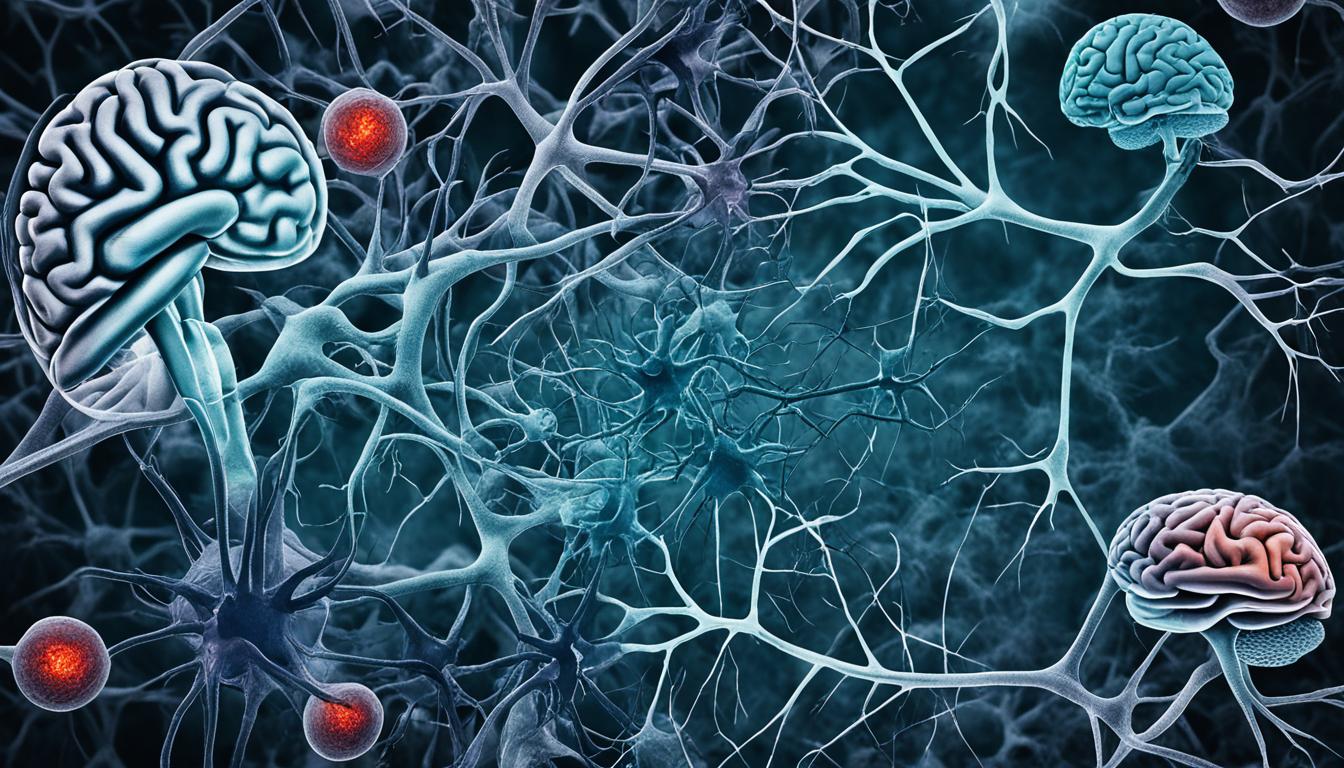Creutzfeldt-Jakob disease (CJD) is a rare, fatal brain disorder. It’s caused by prion proteins and is part of a group affecting people across the globe. About 350 cases are found in the U.S. every year, with an incidence of 1 case per million.
CJD mainly attacks the central nervous system. This leads to quick loss of memory, trouble thinking, and other neurological problems. Due to its dramatic effects, it’s a major concern for public health.
Key Takeaways:
- Variant CJD is a rare, fatal degenerative brain disorder caused by prion proteins.
- Rapidly progressive dementia, cognitive impairment, and neurological symptoms are common in CJD.
- CJD has an incidence rate of 1 case per million per year.
- Approximately 350 cases of CJD are diagnosed annually in the United States.
- Stem cell therapy is being explored as a potential novel approach for the diagnosis and treatment of CJD.
Symptoms and Diagnosis of Variant CJD
Variant CJD shows different symptoms. Early signs include forgetfulness and memory problems. You might also notice confusion, and disorientation.
The disease can cause changes in how you act. It might affect how you see things and understand them. You could experience hallucinations or believe things that aren’t true. Walking and moving might become hard.
Diagnosing Variant CJD is hard because symptoms can differ. Doctors might do a deep check-up. They could use MRIs to look inside your brain and EEGs to check brain waves. Testing fluid around the brain can also be done. This helps rule out other possible diseases.
Rare Symptoms of Variant CJD
Sometimes, Variant CJD can lead to rare problems, like:
- Insomnia or changes in sleep patterns
- Speech difficulties or aphasia
- Severe fatigue and weakness
- Sensory impairments
- Depression and anxiety
To be sure about Variant CJD, special tests are needed. These tests look at brain tissue closely. They check for certain proteins that are a sign of the disease.
| Symptoms | Diagnostic Procedures |
|---|---|
| Early signs of forgetfulness, memory problems, confusion, and disorientation | Thorough clinical examination |
| Behavior and personality changes | Imaging studies such as MRI |
| Vision and processing information problems | EEG to assess brain activity |
| Hallucinations or delusions | Cerebrospinal fluid analysis |
| Difficulties with muscle coordination and balance | Neuropathologic and immunodiagnostic testing of brain tissue |
| Uncontrolled muscle movements and spasms, seizures, and paralysis | Biopsy or autopsy |
Causes and Risk Factors of Variant CJD
Variant CJD is a rare, deadly brain disease. It happens when misfolded prion proteins build up in the brain. Prions are odd proteins that can change normal ones, starting brain problems.
The main cause of this process is unclear. But protein misfolding seems to be a key issue. These misshapen proteins mess up brain cells. This leads to brain cell death over time.
Some people get Variant CJD for no known reason. Others might have it in their genes. Changes in certain genes can make someone more likely to get the disease.
Eating infected beef is a major risk for variant CJD. This is linked to mad cow disease. Infected beef has these harmful prions. When humans eat it, they can get the disease too.
This eating risk led to outbreaks in the UK and France. During those times, eating bad beef increased the disease rates. The disease spread this way.
Summary:
Misfolded prion proteins are at the core of Variant CJD. Though we don’t fully get why proteins misfold, gene issues and bad beef are huge risks. Knowing and dealing with these triggers is key to fighting this disease.
Stem Cell Therapy for Variant CJD
Stem cell therapy is becoming a key area in neurology, showing promise for variant CJD. It could help diagnose and treat this disease by regenerating brain tissue. This research might change how we think about and treat CJD with new therapies.
While still new, stem cell therapy offers a fresh strategy against variant CJD. Experts hope to gain new insights and create better treatments with this approach. It gives hope that someday, prion diseases will have better treatment outcomes.
Scientists are working hard to uncover CJD’s secrets and explore stem cell therapy’s benefits. Their efforts could lead to managing neurological disorders better. They bring us closer to a future where variant CJD could be controlled more effectively.

